aa196d52d63b5fc56b4d82379145c934.ppt
- Количество слайдов: 108

Ch 18 Global Climate Change Part 2: Environmental Issues and the Search for Solutions Power. Point® Slides prepared by Jay Withgott and Heidi Marcum Copyright © 2006 Pearson Education, Inc. , publishing as Benjamin Cummings Copyright © 2008 Pearson Education, Inc. , publishing as Pearson Benjamin Cummings

This lecture will help you understand: • The Earth’s climate system • Human influences on the atmosphere and climate • Methods of climate research • Impacts of global climate change • Ways we can respond to climate change Copyright © 2008 Pearson Education, Inc. , publishing as Pearson Benjamin Cummings

Central Case: Rising seas may flood the M? ? • Visiting tourists think of the M-- Islands in the Indian Ocean as paradise • The islands could be submerged by rising seas accompanying global climate change • The government has already evacuated residents from of the lowest-lying islands Copyright © 2008 Pearson Education, Inc. , publishing as Pearson Benjamin Cummings

Central Case: Rising seas may flood the Maldives • Visiting tourists think of the Maldives Islands in the Indian Ocean as paradise • The islands could be submerged by rising seas accompanying global climate change • The government has already evacuated residents from of the lowest-lying islands Copyright © 2008 Pearson Education, Inc. , publishing as Pearson Benjamin Cummings

Our dynamic climate • Climate influences everything around us • The Fourth Assessment Report of the (I? ? P? ? C? ? ) made it clear that: - Climate is changing, we are the cause, and this change is already exerting impacts that will become increasingly severe • Al Gore’s movie An Inconvenient Truth has been seen by millions • Climate change is the fastest-moving area of environmental science today Copyright © 2008 Pearson Education, Inc. , publishing as Pearson Benjamin Cummings

Our dynamic climate • Climate influences everything around us • The Fourth Assessment Report of the Intergovernmental Panel on Climate Change (IPCC) made it clear that: - Climate is changing, we are the cause, and this change is already exerting impacts that will become increasingly severe • Al Gore’s movie An Inconvenient Truth has been seen by millions • Climate change is the fastest-moving area of environmental science today Copyright © 2008 Pearson Education, Inc. , publishing as Pearson Benjamin Cummings

What is climate change? (1)? ? = an area’s long-term atmospheric conditions - Temperature, moisture content, wind, precipitation, etc. (2)? ? = conditions at localized sites over hours or days • Global climate change = describes trends and variations in Earth’s climate - Temperature, precipitation, storm frequency • Global warming = an increase in Earth’s ? ? ? - Earth’s climate has varied naturally through time - The rapid climatic changes taking place now are due to human activity: fossil fuels, combustion, and deforestation Copyright © 2008 Pearson Education, Inc. , publishing as Pearson Benjamin Cummings

What is climate change? • Climate = an area’s long-term atmospheric conditions - Temperature, moisture content, wind, precipitation, etc. • Weather = conditions at localized sites over hours or days • Global climate change = describes trends and variations in Earth’s climate - Temperature, precipitation, storm frequency • Global warming = an increase in Earth’s average temperature - Earth’s climate has varied naturally through time - The rapid climatic changes taking place now are due to human activity: fossil fuels, combustion, and deforestation Copyright © 2008 Pearson Education, Inc. , publishing as Pearson Benjamin Cummings

Sun and atmosphere keep the Earth warm Name these Three factors exert more influence on climate than all others Copyright © 2008 Pearson Education, Inc. , publishing as Pearson Benjamin Cummings

Sun and atmosphere keep the Earth warm • Three factors exert more influence on climate than all others The Sun = without it, the Earth would be dark and frozen - Also supplies most of our planet’s energy The atmosphere = without it, the Earth’s temperature would be much colder - Earth’s atmosphere, clouds, land, ice, and water absorb 70% of incoming solar radiation The oceans = shape climate by storing and transporting heat and moisture Copyright © 2008 Pearson Education, Inc. , publishing as Pearson Benjamin Cummings

The fate of solar radiation Copyright © 2008 Pearson Education, Inc. , publishing as Pearson Benjamin Cummings

Greenhouse gases warm the lower atmosphere • As Earth’s surface absorbs solar radiation, the surface increases in temperature and emits infrared radiation • Greenhouse gases = atmospheric gases that absorb infrared radiation - Name top 6 & their chemical formulas - Greenhouse gases differ in their ability to warm the troposphere and surface Copyright © 2008 Pearson Education, Inc. , publishing as Pearson Benjamin Cummings

Greenhouse gases warm the lower atmosphere • As Earth’s surface absorbs solar radiation, the surface increases in temperature and emits infrared radiation • Greenhouse gases = atmospheric gases that absorb infrared radiation - Water vapor, ozone, carbon dioxide, nitrous oxide, methane, chlorofluorocarbons (CFCs) - Greenhouse gases differ in their ability to warm the troposphere and surface Copyright © 2008 Pearson Education, Inc. , publishing as Pearson Benjamin Cummings

The greenhouse effect • After absorbing radiation, greenhouse gases re-emit infrared energy - Some energy is lost to space - Greenhouse effect = some energy travels back downward, warming the atmosphere and planet’s surface Name this term? ? ? = the relative ability of one molecule of a given greenhouse gas to contribute to warming - Expressed in relation to carbon dioxide (potential = 1) - ? ? are 12, 000 times as potent as carbon dioxide Copyright © 2008 Pearson Education, Inc. , publishing as Pearson Benjamin Cummings

The greenhouse effect • After absorbing radiation, greenhouse gases re-emit infrared energy - Some energy is lost to space - Greenhouse effect = some energy travels back downward, warming the atmosphere and planet’s surface • Global potential = the relative ability of one molecule of a given greenhouse gas to contribute to warming - Expressed in relation to carbon dioxide (potential = 1) - Hydrochlorofluorocarbons are 12, 000 times as potent as carbon dioxide Copyright © 2008 Pearson Education, Inc. , publishing as Pearson Benjamin Cummings

Which gas is of primary concern • Not the most potent greenhouse gas, but it is extremely abundant - The major contributor to global warming • Human activities have boosted atmospheric concentrations from 280 parts per million (ppm) to 383 ppm - To their highest levels in more than 650, 000 years Copyright © 2008 Pearson Education, Inc. , publishing as Pearson Benjamin Cummings

Carbon dioxide is of primary concern • Not the most potent greenhouse gas, but it is extremely abundant - The major contributor to global warming • Human activities have boosted atmospheric concentrations from 280 parts per million (ppm) to 383 ppm - To their highest levels in more than 650, 000 years Copyright © 2008 Pearson Education, Inc. , publishing as Pearson Benjamin Cummings

What caused levels of CO 2 to increase? • Burned fossil fuels in our homes, factories, and automobiles - Transferred large amounts of carbon dioxide from lithospheric reservoirs into the atmosphere - The main reason atmospheric carbon dioxide concentrations have increased so dramatically ? ? has contributed to rising atmospheric CO 2 concentration - serve as sinks for recently active carbon - Their removal reduces the biosphere’s ability to absorb carbon dioxide from the atmosphere Copyright © 2008 Pearson Education, Inc. , publishing as Pearson Benjamin Cummings

What caused levels of CO 2 to increase? • Burned fossil fuels in our homes, factories, and automobiles - Transferred large amounts of carbon dioxide from lithospheric reservoirs into the atmosphere - The main reason atmospheric carbon dioxide concentrations have increased so dramatically • Deforestation has contributed to rising atmospheric CO 2 concentration - Forests serve as sinks for recently active carbon - Their removal reduces the biosphere’s ability to absorb carbon dioxide from the atmosphere Copyright © 2008 Pearson Education, Inc. , publishing as Pearson Benjamin Cummings

Other greenhouse gases add to warming (1)? = fossil fuel deposits, livestock, landfills, and crops such as rice (2)? = feedlots, chemical manufacturing plants, auto emissions, and synthetic nitrogen fertilizers (3)? = risen due to photochemical smog • Halocarbon gases (CFCs) = are declining due to the M? ? Protocol (4)? = the most abundant greenhouse gas and contributes most to the greenhouse effect - Could increase cloudiness, which might slow global warming by reflecting more solar radiation back into space Copyright © 2008 Pearson Education, Inc. , publishing as Pearson Benjamin Cummings

Other greenhouse gases add to warming • Methane = fossil fuel deposits, livestock, landfills, and crops such as rice • Nitrous oxide = feedlots, chemical manufacturing plants, auto emissions, and synthetic nitrogen fertilizers • Ozone = risen due to photochemical smog • Halocarbon gases (CFCs) = are declining due to the Montreal Protocol • Water vapor = the most abundant greenhouse gas and contributes most to the greenhouse effect - Could increase cloudiness, which might slow global warming by reflecting more solar radiation back into space Copyright © 2008 Pearson Education, Inc. , publishing as Pearson Benjamin Cummings

U. S. emissions of major greenhouse gases Copyright © 2008 Pearson Education, Inc. , publishing as Pearson Benjamin Cummings

? ? may exert a cooling effect (1)? A? ? ? = microscopic droplets and particles that have either a warming or cooling effect (2)? ? , or black carbon aerosols, cause warming by absorbing solar energy - But, most tropospheric aerosols cool the atmosphere by reflecting the Sun’s rays • Sulfate aerosols produced by fossil fuel combustion may slow global warming, at least in the short term - Come from what event that then? ? ? reduce sunlight reaching the earth and cool the Earth Copyright © 2008 Pearson Education, Inc. , publishing as Pearson Benjamin Cummings

Aerosols may exert a cooling effect • Aerosols = microscopic droplets and particles that have either a warming or cooling effect • Soot, or black carbon aerosols, cause warming by absorbing solar energy - But, most tropospheric aerosols cool the atmosphere by reflecting the Sun’s rays • Sulfate aerosols produced by fossil fuel combustion may slow global warming, at least in the short term - Volcanic eruptions reduce sunlight reaching the earth and cool the Earth Copyright © 2008 Pearson Education, Inc. , publishing as Pearson Benjamin Cummings

? ? expresses change in energy • Scientists estimate the influence of factors over Earth’s energy balance • R? f? = the amount of change in energy that a given factor causes - Positive forcing warms the surface; negative forcing cools it • Compared with the pre-industrial Earth, Earth is experiencing radiative forcing of 1. 6 watts/m 2 - Enough to alter the climate Copyright © 2008 Pearson Education, Inc. , publishing as Pearson Benjamin Cummings

Radiative forcing expresses change in energy • Scientists estimate the influence of factors over Earth’s energy balance • Radiative forcing = the amount of change in energy that a given factor causes - Positive forcing warms the surface; negative forcing cools it • Compared with the pre-industrial Earth, Earth is experiencing radiative forcing of 1. 6 watts/m 2 - Enough to alter the climate Copyright © 2008 Pearson Education, Inc. , publishing as Pearson Benjamin Cummings

Name these cycles that influence climate • cycles = periodic changes in Earth’s rotation and orbit around the Sun - Alter the way solar radiation is distributed over Earth’s surface - By modifying patterns of atmospheric heating, these cycles trigger long-term climate variation such as periodic glaciation Copyright © 2008 Pearson Education, Inc. , publishing as Pearson Benjamin Cummings

Milankovitch cycles influence climate • Milankovitch cycles = periodic changes in Earth’s rotation and orbit around the Sun - Alter the way solar radiation is distributed over Earth’s surface - By modifying patterns of atmospheric heating, these cycles trigger long-term climate variation such as periodic glaciation Copyright © 2008 Pearson Education, Inc. , publishing as Pearson Benjamin Cummings

These 2 factors influence climate (1)? = drives temperature change on Earth’s surface - The Sun varies in the radiation it emits - Variation in solar energy (i. e. , solar flares) has not been great enough to change Earth’s temperature (2)? ? = this holds 50 times more carbon than the atmosphere and absorbs it from the atmosphere - Carbon absorption by them is slowing global warming but not preventing it - Warmer ones absorb less CO 2 because gases are less soluble in warmer water – a positive feedback effect that accelerates warming Copyright © 2008 Pearson Education, Inc. , publishing as Pearson Benjamin Cummings

Solar output & ocean absorption influence climate • Solar output = drives temperature change on Earth’s surface - The Sun varies in the radiation it emits - Variation in solar energy (i. e. , solar flares) has not been great enough to change Earth’s temperature • Ocean absorption = the ocean holds 50 times more carbon than the atmosphere and absorbs it from the atmosphere - Carbon absorption by the oceans is slowing global warming but not preventing it - Warmer oceans absorb less CO 2 because gases are less soluble in warmer water – a positive feedback effect that accelerates warming Copyright © 2008 Pearson Education, Inc. , publishing as Pearson Benjamin Cummings

Ocean circulation and ENSO influence climate • Ocean circulation = ocean water exchanges tremendous amounts of heat with the atmosphere, and ocean currents move energy from place to place • El Niño-southern oscillation (ENSO) = a systematic shift in atmospheric pressure, sea surface temperature, and ocean circulation in the tropical Pacific Sketch the change During an ENSO event Copyright © 2008 Pearson Education, Inc. , publishing as Pearson Benjamin Cummings

Ocean circulation and ENSO influence climate • Ocean circulation = ocean water exchanges tremendous amounts of heat with the atmosphere, and ocean currents move energy from place to place • El Niño-southern oscillation (ENSO) = a systematic shift in atmospheric pressure, sea surface temperature, and ocean circulation in the tropical Pacific Copyright © 2008 Pearson Education, Inc. , publishing as Pearson Benjamin Cummings

El Niño • Normally, winds blow from east to west along the equator, from high to low pressure • Westward-moving surface waters allow nutrient-rich upwelling along the coast of Peru • ENSO occurs when air pressure increases in where? ? and decreases in the where? ? ? , causing the equatorial winds to weaken • Water flows eastward, suppressing u? ? , shutting down delivery of nutrients that support aquatic life • Coastal industries are devastated, global weather is changed Copyright © 2008 Pearson Education, Inc. , publishing as Pearson Benjamin Cummings

El Niño • Normally, winds blow from east to west along the equator, from high to low pressure • Westward-moving surface waters allow nutrient-rich upwelling along the coast of Peru • ENSO occurs when air pressure increases in the western Pacific and decreases in the eastern Pacific, causing the equatorial winds to weaken • Water flows eastward, suppressing upwellings, shutting down delivery of nutrients that support aquatic life • Coastal industries are devastated, global weather is changed Copyright © 2008 Pearson Education, Inc. , publishing as Pearson Benjamin Cummings

La Niña events • The opposite of El Niño events - Cold surface waters extend far westward in the equatorial Pacific and weather patterns are affected in opposite ways • ENSO cycles are periodic, occurring every 2 -8 years - Globally warming air and sea temperatures may be increasing their frequency and strength Copyright © 2008 Pearson Education, Inc. , publishing as Pearson Benjamin Cummings

Name this type of circulation ? ? circulation = a worldwide current system in which warmer, fresher water moves along the surface; and colder, saltier water moves deep beneath the surface - Warm surface water carries heat to Europe - Stands for what? (NADW) = the deep portion of the this circulation, consisting of dense, cool water that sinks - Interrupting the this circulation could trigger rapid climate change Copyright © 2008 Pearson Education, Inc. , publishing as Pearson Benjamin Cummings

Thermohaline circulation • Thermohaline circulation = a worldwide current system in which warmer, fresher water moves along the surface; and colder, saltier water moves deep beneath the surface - Warm surface water carries heat to Europe - North American Deep Water (NADW) = the deep portion of thermohaline circulation, consisting of dense, cool water that sinks - Interrupting thermohaline circulation could trigger rapid climate change Copyright © 2008 Pearson Education, Inc. , publishing as Pearson Benjamin Cummings

NADW is vulnerable • If Greenland’s ice melts, freshwater runoff would dilute ocean waters, making them less dense, and stopping NADW - Some data suggest thermohaline circulation is slowing • Europe would rapidly cool, as shown in The Day After Tomorrow, a movie which exaggerated the impacts Copyright © 2008 Pearson Education, Inc. , publishing as Pearson Benjamin Cummings

? ? tell us about the past • Name these? ? = types of indirect evidence that serve as substitutes for direct measurements - Shed light on past climate - Ice caps, ice sheets, and glaciers hold clues to Earth’s climate - Trapped bubbles in ice cores show atmospheric composition, greenhouse gas concentration, temperature trends, snowfall, solar activity, and frequency of fires Copyright © 2008 Pearson Education, Inc. , publishing as Pearson Benjamin Cummings

Proxy indicators tell us about the past • Proxy indicators = types of indirect evidence that serve as substitutes for direct measurements - Shed light on past climate - Ice caps, ice sheets, and glaciers hold clues to Earth’s climate - Trapped bubbles in ice cores show atmospheric composition, greenhouse gas concentration, temperature trends, snowfall, solar activity, and frequency of fires Copyright © 2008 Pearson Education, Inc. , publishing as Pearson Benjamin Cummings

More proxy indicators • Cores in sediment beds preserve pollen grains and other plant remnants • Tree rings indicate age, wetness of the season, droughts, and seasonal growth • Researchers also gather data on past ocean conditions from coral reefs • Scientists need to combine multiple records to get a global perspective Copyright © 2008 Pearson Education, Inc. , publishing as Pearson Benjamin Cummings

Direct atmospheric sampling tells us about the present Trends in atmospheric concentrations of carbon dioxide show that concentrations have increased from 315 ppm to 383 ppm Copyright © 2008 Pearson Education, Inc. , publishing as Pearson Benjamin Cummings

Models help us understand climate • Coupled general circulation model (climate models) = programs that combine what is known about atmospheric circulation, ocean circulation, atmosphere-ocean interactions, and feedback mechanisms to simulate climate processes - These models are becoming more reliable in predicting climate change Copyright © 2008 Pearson Education, Inc. , publishing as Pearson Benjamin Cummings

Results from three simulations • Figure (a) shows natural climate factors only - Volcanoes • Figure (b) shows only human factors - Emissions of greenhouse gases • Figure (c) shows both factors Copyright © 2008 Pearson Education, Inc. , publishing as Pearson Benjamin Cummings

Current and future trends and impacts Evidence that climate conditions have changed since industrialization has increased • Intergovernmental Panel on Climate Change (IPCC) - An international panel of scientists and government officials established in 1988 - Has presented a series of reports on the synthesis of scientific information concerning climate change Copyright © 2008 Pearson Education, Inc. , publishing as Pearson Benjamin Cummings

The fourth assessment report • Fourth Assessment Report (2007) - Consensus of scientific climate research from around the world - Summarizes thousands of studies - It documents observed trends in surface temperature, precipitation patterns, snow and ice cover, sea levels, storm intensity, etc. - Predicts future changes, addressing impacts of current and future climate change on wildlife, ecosystems, and human societies - Discusses possible strategies to pursue in response to climate change Copyright © 2008 Pearson Education, Inc. , publishing as Pearson Benjamin Cummings

Copyright © 2008 Pearson Education, Inc. , publishing as Pearson Benjamin Cummings

Temperature increases will continue • The IPCC report concludes that average surface temperatures on earth have been rising since 1906, with most of the increase occurring in the last few decades Copyright © 2008 Pearson Education, Inc. , publishing as Pearson Benjamin Cummings

Temperature changes are greatest in the Arctic • Ice caps are melting • Polar bears are starving • Storms are increasing • Sea ice is thinning Copyright © 2008 Pearson Education, Inc. , publishing as Pearson Benjamin Cummings

Temperatures will rise 0. 2 degree Celsius per decade • More frequent heat waves • Temperature change will vary by region • Stronger storms Copyright © 2008 Pearson Education, Inc. , publishing as Pearson Benjamin Cummings

Changes in precipitation vary by region • Some regions are receiving more precipitation than usual, and others are receiving less • Droughts have become more frequent and severe - Harming agriculture, promoting soil erosion, reducing drinking water supplies, and encouraging forest fires • Heavy rains have contributed to flooding - Killing people, destroying homes, and inflicting billions of dollars in damage Copyright © 2008 Pearson Education, Inc. , publishing as Pearson Benjamin Cummings

Projected changes in precipitation Copyright © 2008 Pearson Education, Inc. , publishing as Pearson Benjamin Cummings

Melting snow and ice • Mountaintop glaciers are disappearing - In Glacier National Park, only 27 of 150 glaciers remain - Risks of sudden floods as ice dams burst - Reducing summertime water supplies • Melting of the Greenland ice sheet is accelerating • As ice melts, darker, less-reflective surfaces are exposed and absorb more sunlight, causing more melting Copyright © 2008 Pearson Education, Inc. , publishing as Pearson Benjamin Cummings

Worldwide, glaciers are melting rapidly Copyright © 2008 Pearson Education, Inc. , publishing as Pearson Benjamin Cummings

Rising sea levels • As glaciers and ice melt, increased water will flow into the oceans • As oceans warm, they expand • Leads to beach erosion, coastal floods, and intrusion of salt water into aquifers Copyright © 2008 Pearson Education, Inc. , publishing as Pearson Benjamin Cummings

Coastal areas will flood • Storm surge = temporary and localized rise in sea level brought on by the high tides and winds associated with storms • Cities will be flooded • Millions of people will be displaced from coastal areas • IPCC predicts mean sea level to be 18 -59 cm (7 -23 in) higher than today’s at the end of the 21 st century Copyright © 2008 Pearson Education, Inc. , publishing as Pearson Benjamin Cummings

Climate change affects organisms and ecosystems • Organisms are adapted to their environments, so they are affected when those environments change • Global warming modifies temperature-dependent phenomena - Timing of migration, breeding • Spatial shifts in the range of organisms - Animals and plants will move towards the poles or upward in elevation - 20 -30% of all species will be threatened with extinction • Plants act as carbon sinks; fewer plants means more CO 2 in the atmosphere Copyright © 2008 Pearson Education, Inc. , publishing as Pearson Benjamin Cummings

Climate change exerts societal impacts • Human society is beginning to feel the impacts of climate change • Agriculture: growing seasons shortened, crops more susceptible to droughts and failure; crop production will decrease, worsening hunger • Forestry: increased insect and disease outbreaks, increased chance of forest fires (especially in rainforests) • Health: heat waves and stress can cause death, respiratory ailments, expansion of tropical diseases, increased chance of drowning if storms become intense, hunger-related ailments Copyright © 2008 Pearson Education, Inc. , publishing as Pearson Benjamin Cummings

Heat waves will increase Copyright © 2008 Pearson Education, Inc. , publishing as Pearson Benjamin Cummings

Climate change affects economics • Costs will outweigh benefits • Widen the gap between rich and poor • Will cost 1 -5% GDP on average globally - Poor nations will lose more than rich ones - Climate change could cost 5 -20% of GDP by 2200 Copyright © 2008 Pearson Education, Inc. , publishing as Pearson Benjamin Cummings

Causes and consequences of climate change Copyright © 2008 Pearson Education, Inc. , publishing as Pearson Benjamin Cummings

U. S. Global Change Research Program (1990) • Predicted: - Temperature increases - Worse droughts and flooding - Decreased crop yields and water shortages - Health problems and mortality - Altered forest ecosystems - Lost coastal areas - Undermined Alaskan buildings and roads Copyright © 2008 Pearson Education, Inc. , publishing as Pearson Benjamin Cummings

Predictions from two models By 2030, Illinois will have a climate like Missouri’s. By 2090, it will have a climate like Oklahoma’s. Green = Canadian model Blue = Hadley model Copyright © 2008 Pearson Education, Inc. , publishing as Pearson Benjamin Cummings

The USGCRP was suppressed • Once President G. W. Bush came to power • Climate change is politically divisive: • It challenges entrenched and powerful interests Copyright © 2008 Pearson Education, Inc. , publishing as Pearson Benjamin Cummings
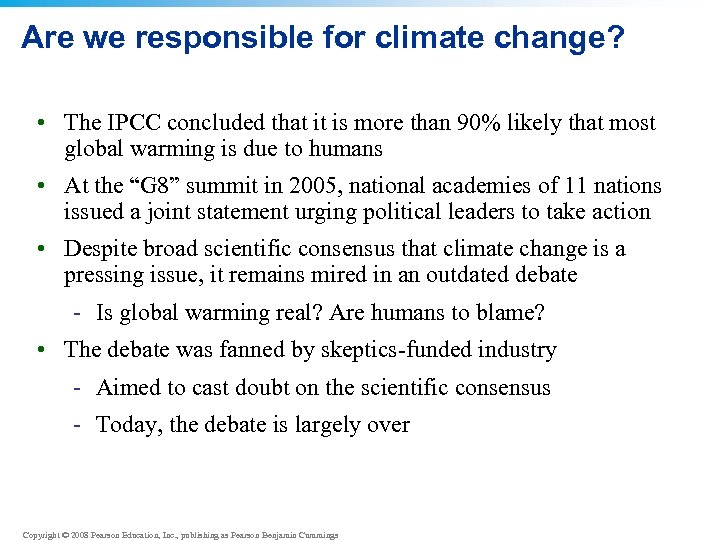
Are we responsible for climate change? • The IPCC concluded that it is more than 90% likely that most global warming is due to humans • At the “G 8” summit in 2005, national academies of 11 nations issued a joint statement urging political leaders to take action • Despite broad scientific consensus that climate change is a pressing issue, it remains mired in an outdated debate - Is global warming real? Are humans to blame? • The debate was fanned by skeptics-funded industry - Aimed to cast doubt on the scientific consensus - Today, the debate is largely over Copyright © 2008 Pearson Education, Inc. , publishing as Pearson Benjamin Cummings

The debate over climate change is over • Most Americans accept that fossil fuel consumption is changing the planet • An Inconvenient Truth helped turn the tide - 84% of people surveyed thought that humans contribute to global warming - Many corporations offer support for greenhouse gas reductions Copyright © 2008 Pearson Education, Inc. , publishing as Pearson Benjamin Cummings

What to pursue? ? ? (1)? = pursue actions that reduce greenhouse gas emissions, in order to lessen severity of future climate change - Renewable energy sources, farm practices to protect soil integrity, preventing deforestation (2)? = accept climate change is happening and pursue strategies to minimize its impacts on us - Criticized as sidestepping • Both are necessary Copyright © 2008 Pearson Education, Inc. , publishing as Pearson Benjamin Cummings

Shall we pursue mitigation or adaptation? • Mitigation = pursue actions that reduce greenhouse gas emissions, in order to lessen severity of future climate change - Renewable energy sources, farm practices to protect soil integrity, preventing deforestation • Adaptation = accept climate change is happening and pursue strategies to minimize its impacts on us - Criticized as sidestepping • Both are necessary Copyright © 2008 Pearson Education, Inc. , publishing as Pearson Benjamin Cummings

We need to act fast The faster we reduce our emissions, the less we will alter climate Copyright © 2008 Pearson Education, Inc. , publishing as Pearson Benjamin Cummings

Name the source… What is the Largest source of U. S. CO 2 emissions • Two ways to reduce fossil fuel use: conservation and efficiency - Arise from technology and individual choices - Replacing worn-down appliances with newer models, lifestyle choices - Use fewer greenhouse-gas-producing products Copyright © 2008 Pearson Education, Inc. , publishing as Pearson Benjamin Cummings

Electricity generation A coal-fired, electricitygenerating power plant • Largest source of U. S. CO 2 emissions • Two ways to reduce fossil fuel use: conservation and efficiency - Arise from technology and individual choices - Replacing worn-down appliances with newer models, lifestyle choices - Use fewer greenhouse-gas-producing products Copyright © 2008 Pearson Education, Inc. , publishing as Pearson Benjamin Cummings

Sources of electricity • We can change the energy we use - Natural gas - Carbon-capture = technologies or approaches that remove CO 2 from power plant emissions - Carbon sequestration (storage) = storing carbon somewhere (underground? ) where it will not seep out - Use technologies and energy sources without using fossil fuels (nuclear, hydroelectric, solar power, etc. ) Copyright © 2008 Pearson Education, Inc. , publishing as Pearson Benjamin Cummings
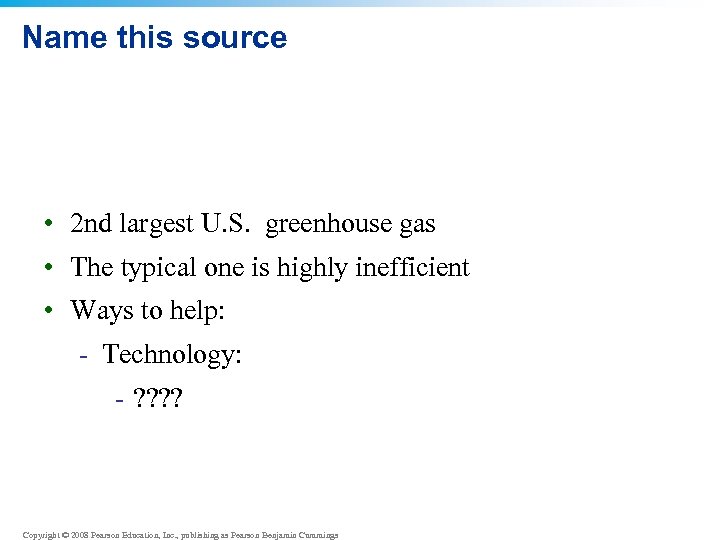
Name this source • 2 nd largest U. S. greenhouse gas • The typical one is highly inefficient • Ways to help: - Technology: - ? ? Copyright © 2008 Pearson Education, Inc. , publishing as Pearson Benjamin Cummings
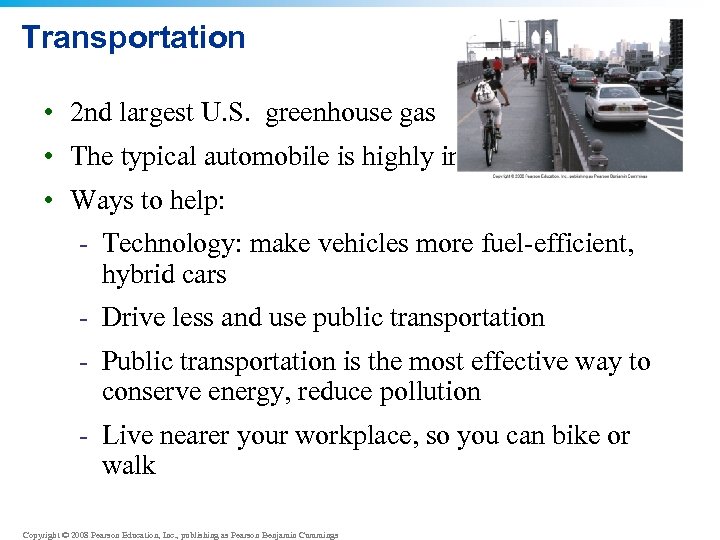
Transportation • 2 nd largest U. S. greenhouse gas • The typical automobile is highly inefficient • Ways to help: - Technology: make vehicles more fuel-efficient, hybrid cars - Drive less and use public transportation - Public transportation is the most effective way to conserve energy, reduce pollution - Live nearer your workplace, so you can bike or walk Copyright © 2008 Pearson Education, Inc. , publishing as Pearson Benjamin Cummings
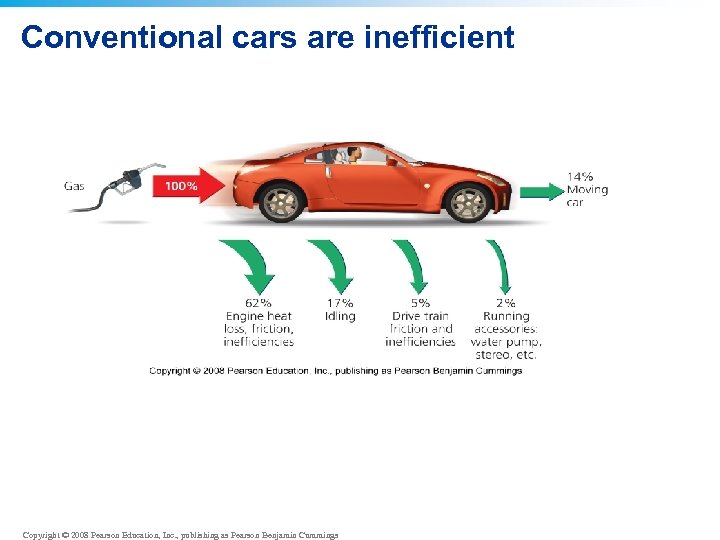
Conventional cars are inefficient Copyright © 2008 Pearson Education, Inc. , publishing as Pearson Benjamin Cummings

We can reduce emissions in other ways, too • Use advances in agriculture, forestry, and waste management - Grow renewable biofuels - Rapid reforestation of deforested areas - Recovering methane from landfills - Recycling, composting, and reduction or reuse of materials Copyright © 2008 Pearson Education, Inc. , publishing as Pearson Benjamin Cummings
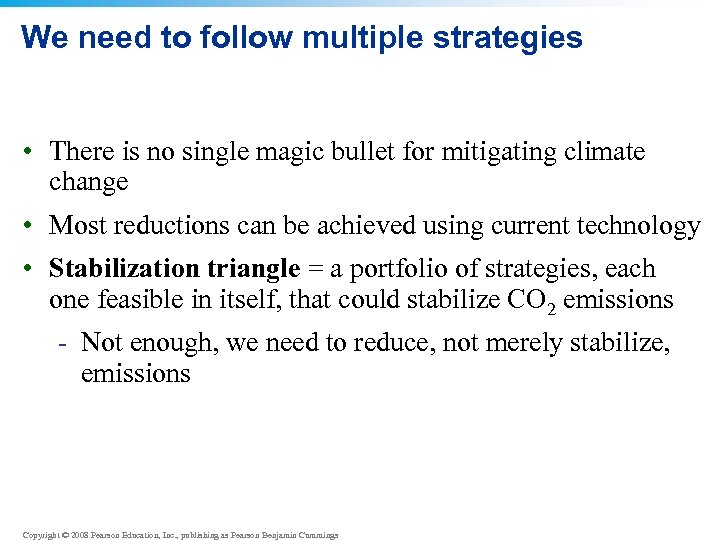
We need to follow multiple strategies • There is no single magic bullet for mitigating climate change • Most reductions can be achieved using current technology • Stabilization triangle = a portfolio of strategies, each one feasible in itself, that could stabilize CO 2 emissions - Not enough, we need to reduce, not merely stabilize, emissions Copyright © 2008 Pearson Education, Inc. , publishing as Pearson Benjamin Cummings
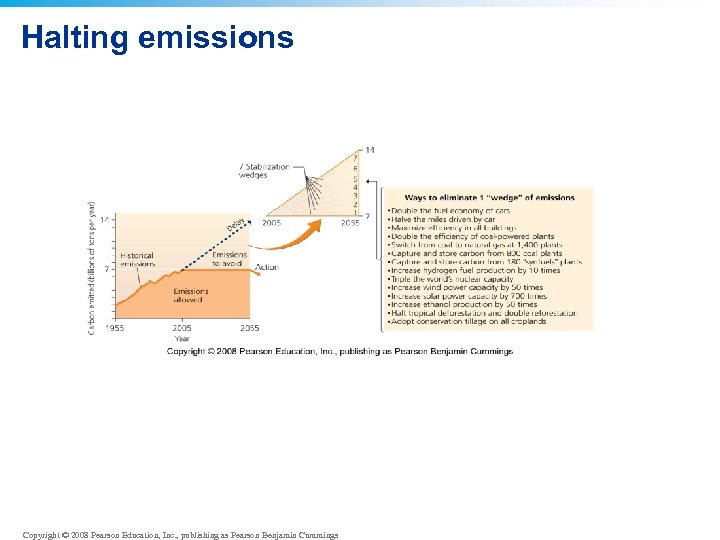
Halting emissions Copyright © 2008 Pearson Education, Inc. , publishing as Pearson Benjamin Cummings

Government mandates or market incentives? • Governmental command-control policy has been vital in safeguarding environmental quality and promoting human well-being - However, mandates are resisted by industry - Market incentives can sometimes be more effective in driving change • Policymakers, industry, commerce, and citizens are searching for ways to employ government and the market to reduce emissions in ways that are fair, economically palatable, effective, and enforceable Copyright © 2008 Pearson Education, Inc. , publishing as Pearson Benjamin Cummings

The FCCC • UN Framework Convention on Climate Change (FCCC) = outlines a plan for reducing greenhouse gas emissions to 1990 levels by the year 2000 through a voluntary, nation-by-nation approach - By the late 1990 s, it was clear that the voluntary approach would not succeed - U. S. emissions increased by 17. 9% from 1990 to 2006 - Germany, with the third most technologically advanced economy in the world, reduced emissions by 17. 2% between 1990 and 2004 • Developing nations created a binding international treaty that would require all signatory nations to reduce their emissions Copyright © 2008 Pearson Education, Inc. , publishing as Pearson Benjamin Cummings
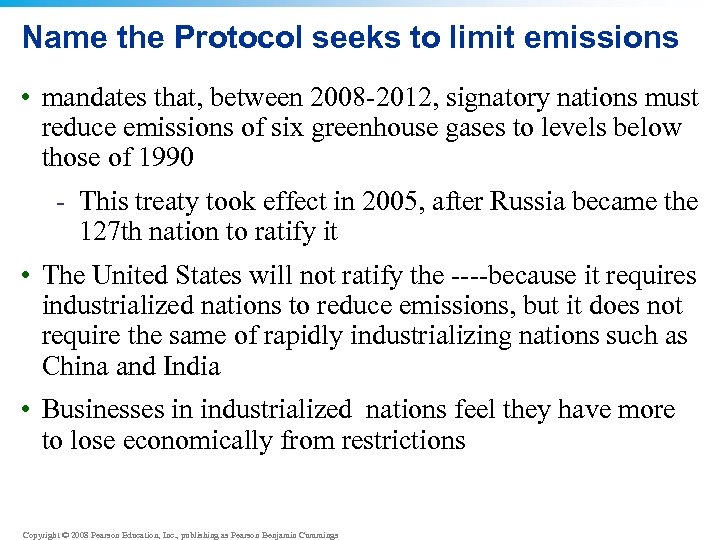
Name the Protocol seeks to limit emissions • mandates that, between 2008 -2012, signatory nations must reduce emissions of six greenhouse gases to levels below those of 1990 - This treaty took effect in 2005, after Russia became the 127 th nation to ratify it • The United States will not ratify the ----because it requires industrialized nations to reduce emissions, but it does not require the same of rapidly industrializing nations such as China and India • Businesses in industrialized nations feel they have more to lose economically from restrictions Copyright © 2008 Pearson Education, Inc. , publishing as Pearson Benjamin Cummings
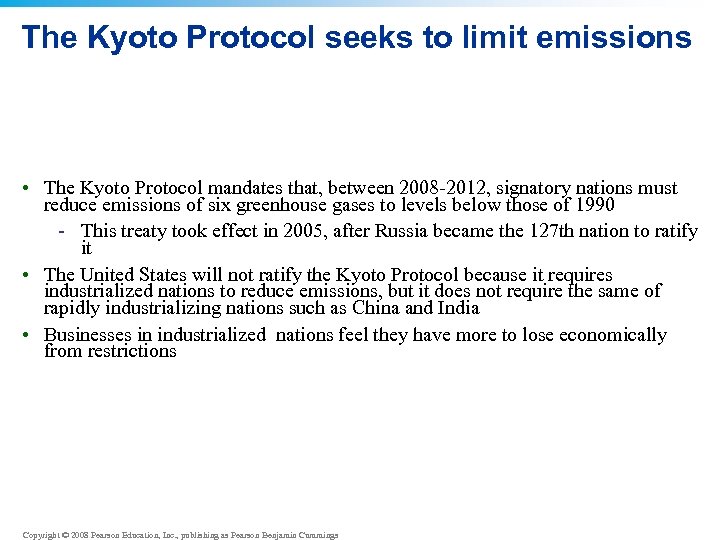
The Kyoto Protocol seeks to limit emissions • The Kyoto Protocol mandates that, between 2008 -2012, signatory nations must reduce emissions of six greenhouse gases to levels below those of 1990 - This treaty took effect in 2005, after Russia became the 127 th nation to ratify it • The United States will not ratify the Kyoto Protocol because it requires industrialized nations to reduce emissions, but it does not require the same of rapidly industrializing nations such as China and India • Businesses in industrialized nations feel they have more to lose economically from restrictions Copyright © 2008 Pearson Education, Inc. , publishing as Pearson Benjamin Cummings

Advancing climate change policy • George W. Bush and Congress will not address climate change - State and local governments across the U. S. are responding and advancing policies to limit greenhouse emissions - Mayors from all 50 states signed the U. S. Mayors Climate Protection Agreement, where the mayors commit their cities to pursue policies to “meet or beat” Kyoto Protocol guidelines • California’s legislature passed the Global Warming Solutions Act, which aims to cut the state’s greenhouse gas emissions 25% by the year 2020 • 10 northeastern states launched the Regional Greenhouse Gas Initiative (RGGI) in 2007, which set up a cap-and-trade program for carbon emissions from power plants Copyright © 2008 Pearson Education, Inc. , publishing as Pearson Benjamin Cummings

Market mechanisms address climate change • Permit trading programs can harness the economic efficiency of the free market to achieve policy goals while allowing business • The price of a permit fluctuates freely in the market, creating the same kinds of financial incentives as any other commodity that is bought and sold in our capitalist system • The Chicago Climate Change is the world’s first emissions trading program for greenhouse gas reduction • The world’s largest cap-and-trade program is the European Union Emission Trading Scheme Copyright © 2008 Pearson Education, Inc. , publishing as Pearson Benjamin Cummings
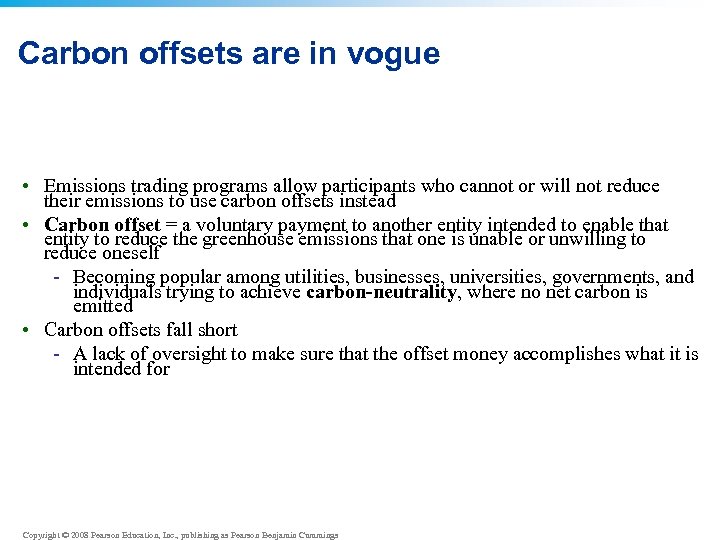
Carbon offsets are in vogue • Emissions trading programs allow participants who cannot or will not reduce their emissions to use carbon offsets instead • Carbon offset = a voluntary payment to another entity intended to enable that entity to reduce the greenhouse emissions that one is unable or unwilling to reduce oneself - Becoming popular among utilities, businesses, universities, governments, and individuals trying to achieve carbon-neutrality, where no net carbon is emitted • Carbon offsets fall short - A lack of oversight to make sure that the offset money accomplishes what it is intended for Copyright © 2008 Pearson Education, Inc. , publishing as Pearson Benjamin Cummings
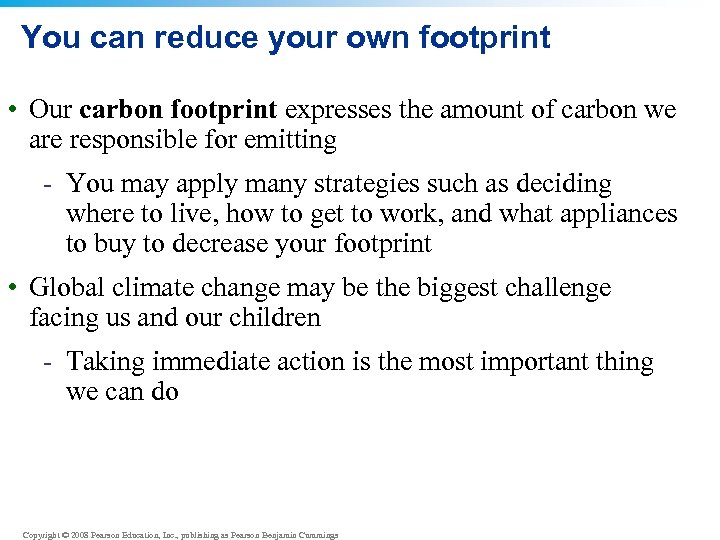
You can reduce your own footprint • Our carbon footprint expresses the amount of carbon we are responsible for emitting - You may apply many strategies such as deciding where to live, how to get to work, and what appliances to buy to decrease your footprint • Global climate change may be the biggest challenge facing us and our children - Taking immediate action is the most important thing we can do Copyright © 2008 Pearson Education, Inc. , publishing as Pearson Benjamin Cummings

Conclusion • Many factors influence Earth’s climate - Human activities play a major role • Climate change is well underway - Further emissions will cause severe impacts • More and more scientists are urging immediate action - Reducing emissions, and mitigating and adapting to a changing climate, represents the foremost challenge for our society Copyright © 2008 Pearson Education, Inc. , publishing as Pearson Benjamin Cummings
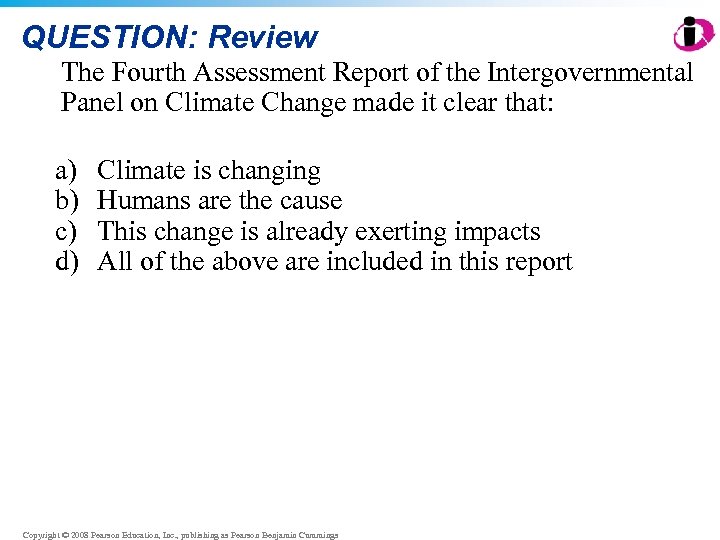
QUESTION: Review The Fourth Assessment Report of the Intergovernmental Panel on Climate Change made it clear that: a) b) c) d) Climate is changing Humans are the cause This change is already exerting impacts All of the above are included in this report Copyright © 2008 Pearson Education, Inc. , publishing as Pearson Benjamin Cummings
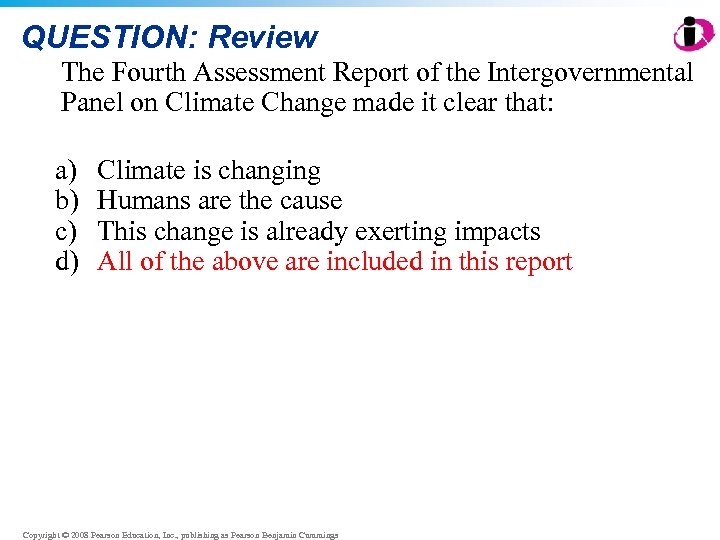
QUESTION: Review The Fourth Assessment Report of the Intergovernmental Panel on Climate Change made it clear that: a) b) c) d) Climate is changing Humans are the cause This change is already exerting impacts All of the above are included in this report Copyright © 2008 Pearson Education, Inc. , publishing as Pearson Benjamin Cummings

QUESTION: Review “Climate” is defined as…. a) b) c) d) Conditions at localized sites Conditions over hours or days An area’s long-term atmospheric conditions Variations in Earth’s temperature Copyright © 2008 Pearson Education, Inc. , publishing as Pearson Benjamin Cummings
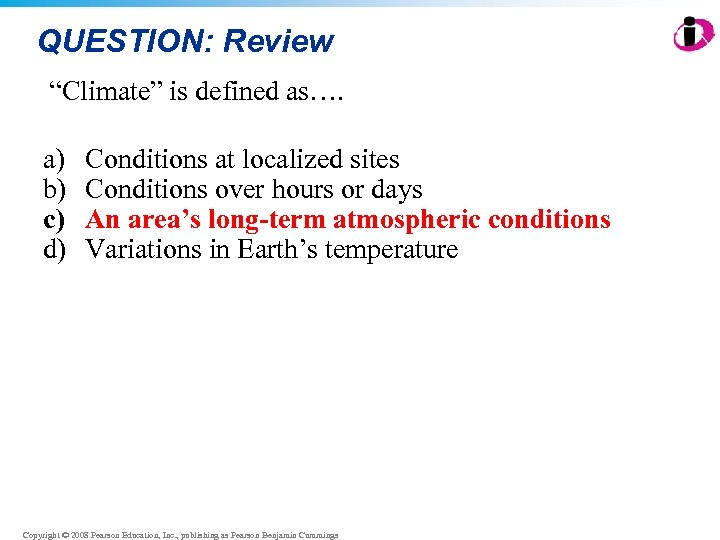
QUESTION: Review “Climate” is defined as…. a) b) c) d) Conditions at localized sites Conditions over hours or days An area’s long-term atmospheric conditions Variations in Earth’s temperature Copyright © 2008 Pearson Education, Inc. , publishing as Pearson Benjamin Cummings
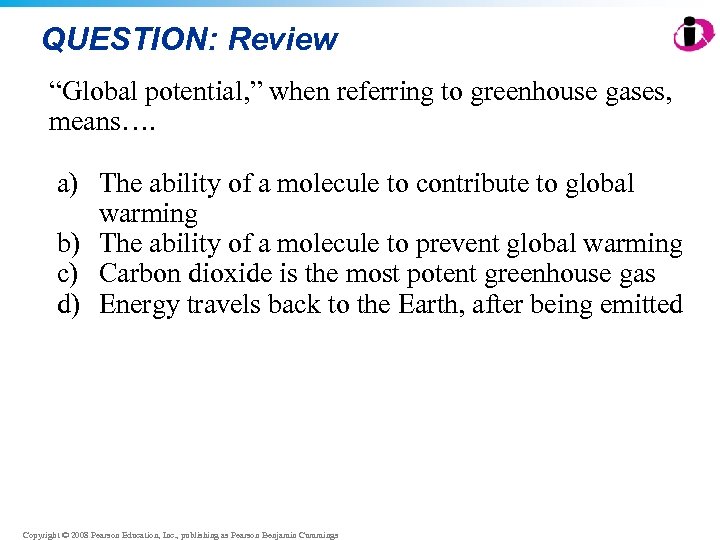
QUESTION: Review “Global potential, ” when referring to greenhouse gases, means…. a) The ability of a molecule to contribute to global warming b) The ability of a molecule to prevent global warming c) Carbon dioxide is the most potent greenhouse gas d) Energy travels back to the Earth, after being emitted Copyright © 2008 Pearson Education, Inc. , publishing as Pearson Benjamin Cummings
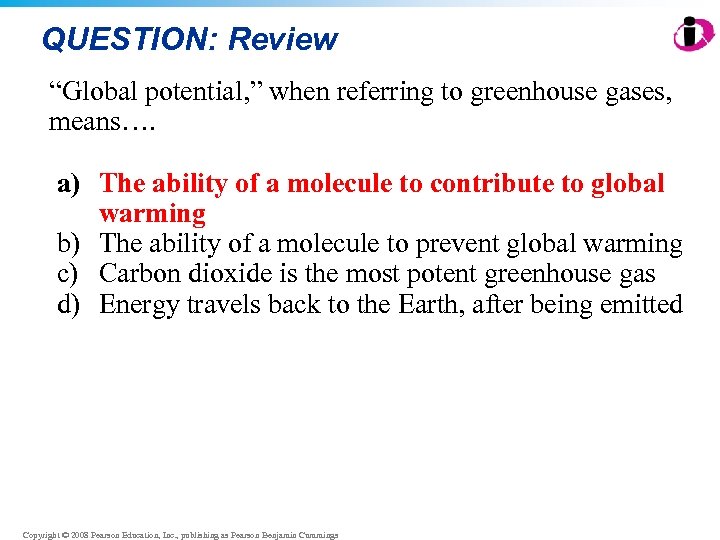
QUESTION: Review “Global potential, ” when referring to greenhouse gases, means…. a) The ability of a molecule to contribute to global warming b) The ability of a molecule to prevent global warming c) Carbon dioxide is the most potent greenhouse gas d) Energy travels back to the Earth, after being emitted Copyright © 2008 Pearson Education, Inc. , publishing as Pearson Benjamin Cummings

QUESTION: Review Which of the following are major contributors of global warming? a) b) c) d) Burning fossil fuels and recycling Burning fossil fuels and deforestation Deforestation and nuclear energy Fossil fuels and nuclear energy Copyright © 2008 Pearson Education, Inc. , publishing as Pearson Benjamin Cummings

QUESTION: Review Which of the following are major contributors of global warming? a) b) c) d) Burning fossil fuels and recycling Burning fossil fuels and deforestation Deforestation and nuclear energy Fossil fuels and nuclear energy Copyright © 2008 Pearson Education, Inc. , publishing as Pearson Benjamin Cummings

QUESTION: Review U. S. emissions of greenhouse gases have…. a) b) c) d) Decreased Stabilized Increased Gone away Copyright © 2008 Pearson Education, Inc. , publishing as Pearson Benjamin Cummings
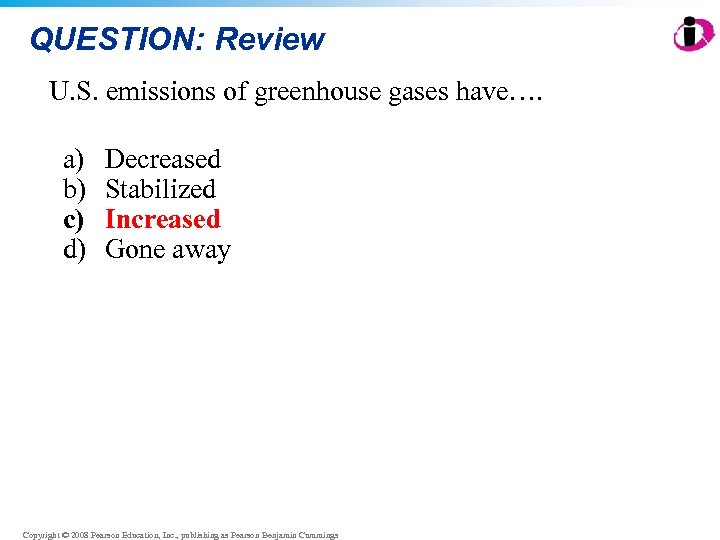
QUESTION: Review U. S. emissions of greenhouse gases have…. a) b) c) d) Decreased Stabilized Increased Gone away Copyright © 2008 Pearson Education, Inc. , publishing as Pearson Benjamin Cummings
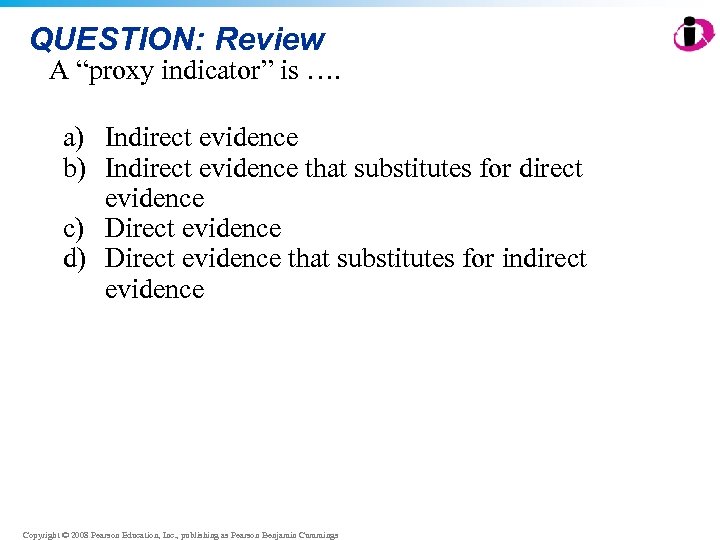
QUESTION: Review A “proxy indicator” is …. a) Indirect evidence b) Indirect evidence that substitutes for direct evidence c) Direct evidence d) Direct evidence that substitutes for indirect evidence Copyright © 2008 Pearson Education, Inc. , publishing as Pearson Benjamin Cummings
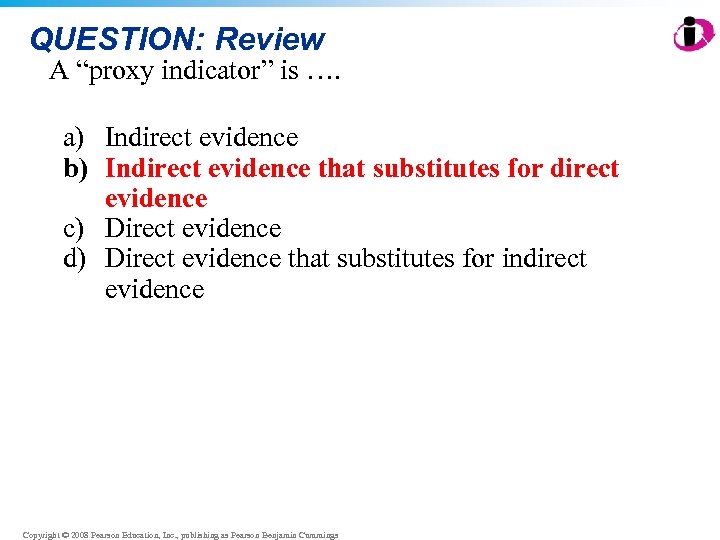
QUESTION: Review A “proxy indicator” is …. a) Indirect evidence b) Indirect evidence that substitutes for direct evidence c) Direct evidence d) Direct evidence that substitutes for indirect evidence Copyright © 2008 Pearson Education, Inc. , publishing as Pearson Benjamin Cummings
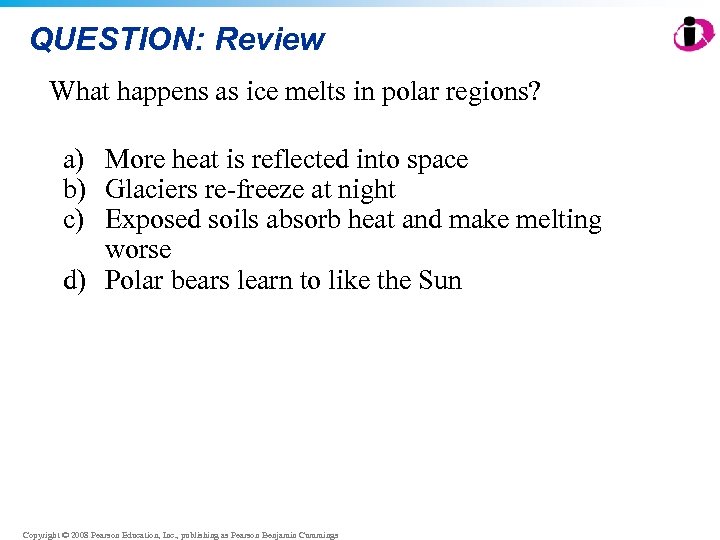
QUESTION: Review What happens as ice melts in polar regions? a) More heat is reflected into space b) Glaciers re-freeze at night c) Exposed soils absorb heat and make melting worse d) Polar bears learn to like the Sun Copyright © 2008 Pearson Education, Inc. , publishing as Pearson Benjamin Cummings

QUESTION: Review What happens as ice melts in polar regions? a) More heat is reflected into space b) Glaciers re-freeze at night c) Exposed soils absorb heat and make melting worse d) Polar bears learn to like the Sun Copyright © 2008 Pearson Education, Inc. , publishing as Pearson Benjamin Cummings

QUESTION: Weighing the Issues Do you think Arctic-living people deserve some sort of compensation from developed nations whose emissions have caused climate change and negatively affected Arctic-living people? a) Yes, because their way of life is being destroyed b) Yes, but compensation should be in the form of helping them move to another area c) No; they need to change their lifestyles to adapt d) No; people have always had to adapt to new conditions Copyright © 2008 Pearson Education, Inc. , publishing as Pearson Benjamin Cummings

QUESTION: Weighing the Issues If people are displaced from their homeland due to climate change, should industrialized nations have to take them in, since fossil fuel burning is responsible for their loss of homes? a) b) c) d) Yes; if we deprive them of their homes, we owe them new ones Yes, but they should have to pay to enter this country No; it’s their tough luck Definitely not; it’s not my problem Copyright © 2008 Pearson Education, Inc. , publishing as Pearson Benjamin Cummings
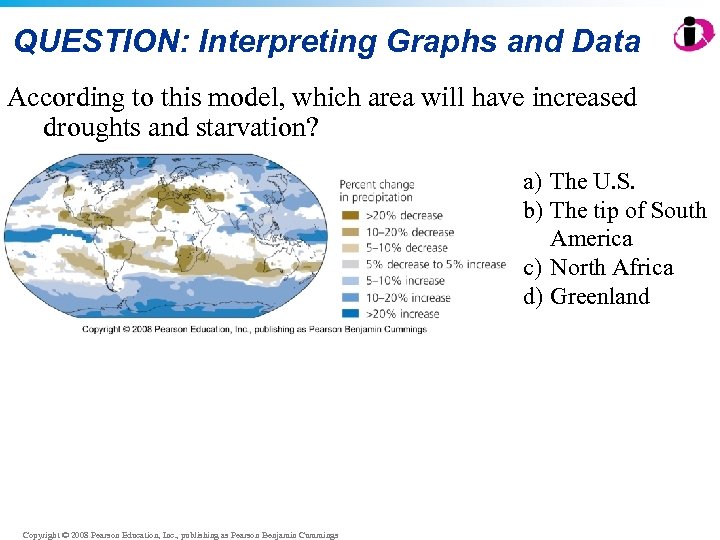
QUESTION: Interpreting Graphs and Data According to this model, which area will have increased droughts and starvation? a) The U. S. b) The tip of South America c) North Africa d) Greenland Copyright © 2008 Pearson Education, Inc. , publishing as Pearson Benjamin Cummings
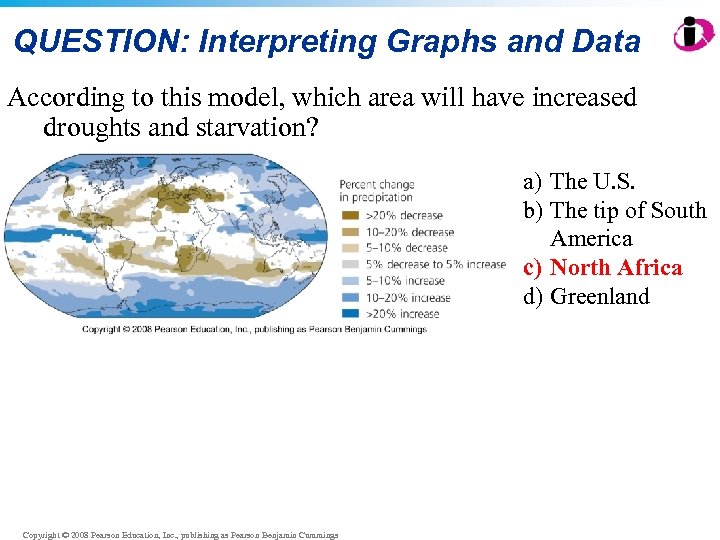
QUESTION: Interpreting Graphs and Data According to this model, which area will have increased droughts and starvation? a) The U. S. b) The tip of South America c) North Africa d) Greenland Copyright © 2008 Pearson Education, Inc. , publishing as Pearson Benjamin Cummings

QUESTION: Interpreting Graphs and Data Which statement is supported by this figure? a) CO 2 emissions have stabilized recently b) CO 2 emissions fluctuate only in Hawaii c) CO 2 emissions have increased drastically d) CO 2 emissions average 320 ppm Copyright © 2008 Pearson Education, Inc. , publishing as Pearson Benjamin Cummings
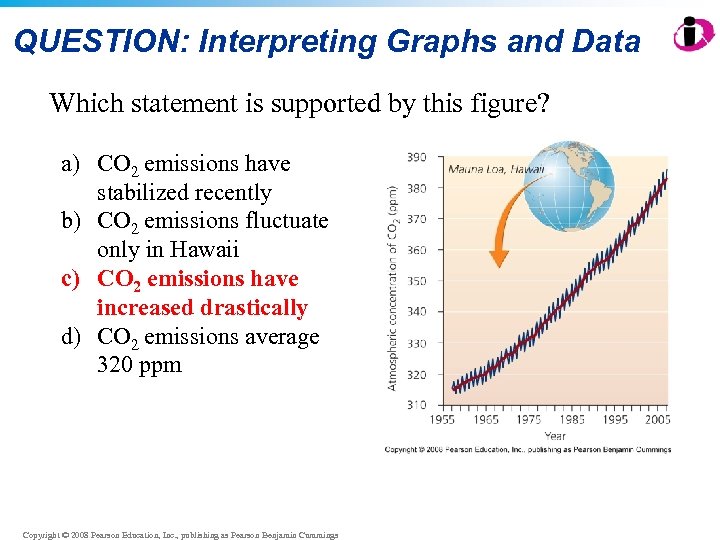
QUESTION: Interpreting Graphs and Data Which statement is supported by this figure? a) CO 2 emissions have stabilized recently b) CO 2 emissions fluctuate only in Hawaii c) CO 2 emissions have increased drastically d) CO 2 emissions average 320 ppm Copyright © 2008 Pearson Education, Inc. , publishing as Pearson Benjamin Cummings

For more practice-test your knowledge Kahoots https: //play. kahoot. it/#/? quiz. Id=4 cd 16 c 27 -3 b 09 -4065 -97 c 8 -b 5834677 e 295 https: //play. kahoot. it/#/? quiz. Id=ba 5 a 4 fc 6 -6122 -4 b 57 -ae 51 -90 bed 82 b 5 a 16 https: //play. kahoot. it/#/? quiz. Id=23 b 24 c 0 f-74 fc-4813 -b 325 -7 e 9488 d 6 aeea Digital flashcards https: //quizlet. com/5377319/chapter-21 -global-climate-change-flash-cards/ https: //quizlet. com/19281205/climate-change-vocabulary-flash-cards/ http: //www. flashcardmachine. com/modern-climatechange. html Copyright © 2008 Pearson Education, Inc. , publishing as Pearson Benjamin Cummings
aa196d52d63b5fc56b4d82379145c934.ppt